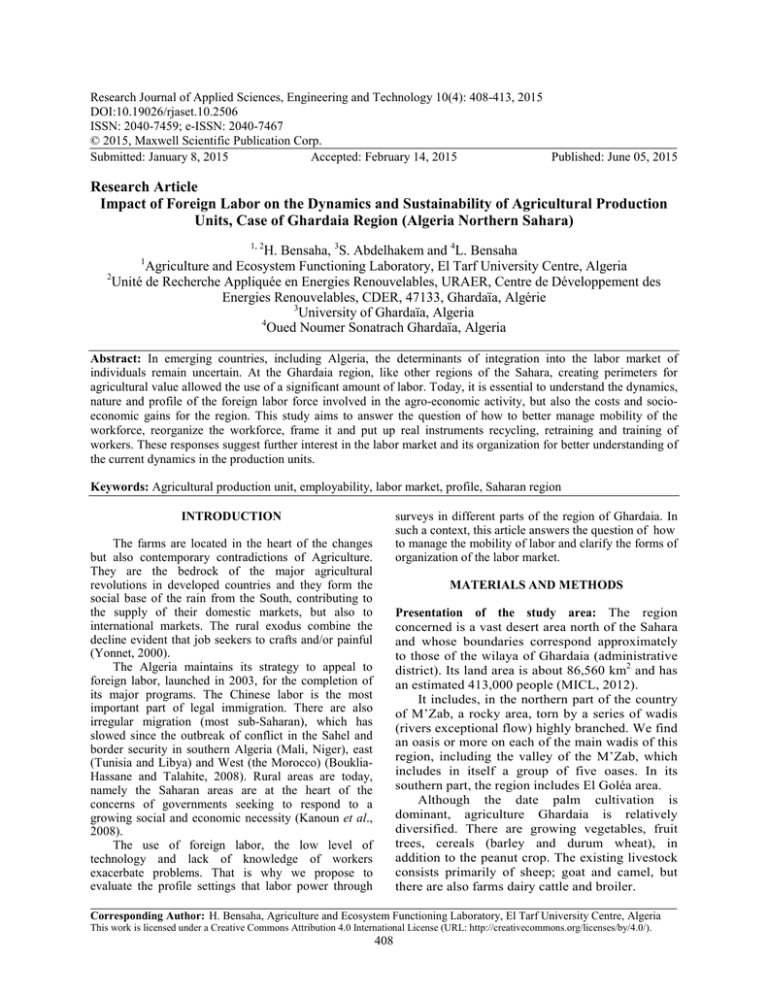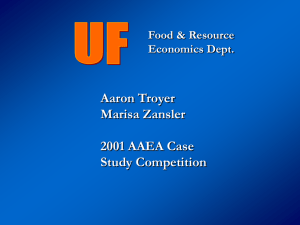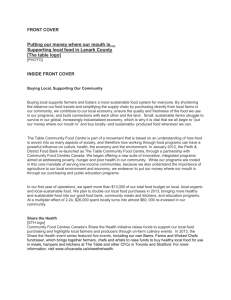Research Journal of Applied Sciences, Engineering and Technology 10(4): 408-413,... DOI:10.19026/rjaset.10.2506
advertisement

Research Journal of Applied Sciences, Engineering and Technology 10(4): 408-413, 2015 DOI:10.19026/rjaset.10.2506 ISSN: 2040-7459; e-ISSN: 2040-7467 © 2015, Maxwell Scientific Publication Corp. Submitted: January 8, 2015 Accepted: February 14, 2015 Published: June 05, 2015 Research Article Impact of Foreign Labor on the Dynamics and Sustainability of Agricultural Production Units, Case of Ghardaia Region (Algeria Northern Sahara) 1, 2 H. Bensaha, 3S. Abdelhakem and 4L. Bensaha Agriculture and Ecosystem Functioning Laboratory, El Tarf University Centre, Algeria 2 Unité de Recherche Appliquée en Energies Renouvelables, URAER, Centre de Développement des Energies Renouvelables, CDER, 47133, Ghardaïa, Algérie 3 University of Ghardaïa, Algeria 4 Oued Noumer Sonatrach Ghardaïa, Algeria 1 Abstract: In emerging countries, including Algeria, the determinants of integration into the labor market of individuals remain uncertain. At the Ghardaia region, like other regions of the Sahara, creating perimeters for agricultural value allowed the use of a significant amount of labor. Today, it is essential to understand the dynamics, nature and profile of the foreign labor force involved in the agro-economic activity, but also the costs and socioeconomic gains for the region. This study aims to answer the question of how to better manage mobility of the workforce, reorganize the workforce, frame it and put up real instruments recycling, retraining and training of workers. These responses suggest further interest in the labor market and its organization for better understanding of the current dynamics in the production units. Keywords: Agricultural production unit, employability, labor market, profile, Saharan region surveys in different parts of the region of Ghardaia. In such a context, this article answers the question of how to manage the mobility of labor and clarify the forms of organization of the labor market. INTRODUCTION The farms are located in the heart of the changes but also contemporary contradictions of Agriculture. They are the bedrock of the major agricultural revolutions in developed countries and they form the social base of the rain from the South, contributing to the supply of their domestic markets, but also to international markets. The rural exodus combine the decline evident that job seekers to crafts and/or painful (Yonnet, 2000). The Algeria maintains its strategy to appeal to foreign labor, launched in 2003, for the completion of its major programs. The Chinese labor is the most important part of legal immigration. There are also irregular migration (most sub-Saharan), which has slowed since the outbreak of conflict in the Sahel and border security in southern Algeria (Mali, Niger), east (Tunisia and Libya) and West (the Morocco) (BoukliaHassane and Talahite, 2008). Rural areas are today, namely the Saharan areas are at the heart of the concerns of governments seeking to respond to a growing social and economic necessity (Kanoun et al., 2008). The use of foreign labor, the low level of technology and lack of knowledge of workers exacerbate problems. That is why we propose to evaluate the profile settings that labor power through MATERIALS AND METHODS Presentation of the study area: The region concerned is a vast desert area north of the Sahara and whose boundaries correspond approximately to those of the wilaya of Ghardaia (administrative district). Its land area is about 86,560 km2 and has an estimated 413,000 people (MICL, 2012). It includes, in the northern part of the country of M’Zab, a rocky area, torn by a series of wadis (rivers exceptional flow) highly branched. We find an oasis or more on each of the main wadis of this region, including the valley of the M’Zab, which includes in itself a group of five oases. In its southern part, the region includes El Goléa area. Although the date palm cultivation is dominant, agriculture Ghardaia is relatively diversified. There are growing vegetables, fruit trees, cereals (barley and durum wheat), in addition to the peanut crop. The existing livestock consists primarily of sheep; goat and camel, but there are also farms dairy cattle and broiler. Corresponding Author: H. Bensaha, Agriculture and Ecosystem Functioning Laboratory, El Tarf University Centre, Algeria This work is licensed under a Creative Commons Attribution 4.0 International License (URL: http://creativecommons.org/licenses/by/4.0/). 408 Res. J. App. Sci. Eng. Technol., 10(4): 408-413, 2015 Table 1: The different farms selected for investigation Number of farming Number of surveyed opportunities farming opportunities Towns Guerrara 473 200 Berriane 334 170 Zelfana 270 123 El Atteuf 104 40 Bounoura 66 24 Daya Ben 28 08 Dahoua Ghardaïa 189 50 Metlili 182 81 El Goléa 175 96 Mansourah 277 164 Hassi Lefhal 362 130 Seb Seb 146 79 Hassi Guara 734 240 Total 3340 1405 70 (%) 42.28 50.89 45.55 38.46 36.36 28.57 58 60 50 40 40 % 30 20 26.45 44.50 54.58 59.20 35.91 48.17 32.69 42.06 10 2 0 Less than 30 30-50 Age More than 50 Fig. 1: Identification of the foreign labor in function of age Sampling: Our approach was based on socio-economic surveys and research with operators and foreign labor, agricultural institutions and local authorities. To conduct our investigations we selected 1405 production units. For our choice, we mainly based on the mass of foreign labor (≥01), the specialization of the owner, as well as farm size (≥02 ha). As part of this study, a representative sample of the reality of agricultural economic units in the region was chosen. It consisted of 1405 farms larger than 02 ha. The farms of less than 02 ha have been deliberately excluded from the sample of work (Table 1). Like all scientific research, aimed concrete observation, our approach was to analyze the various data and draw the necessary conclusions. Farms were monitored from May 2013 to March 2014. The following table lists the different selected farms to be investigated. The prospect of a decline in the labor force over the next 10 years is similar to the scarcity of the factors of production. Substitution of capital for labor witnessed restrictions, especially regarding labor; businesses will face shortages of labor, which, in a competitive environment, will also lead to rising average wages. In this sense, the call to the foreign labor force can be a solution (Deneuve, 2001). Root of the foreign workers: Identifying labor proves extremely important, because the variables studied, are an indicator of how the work force took over the task of their farms. Like many other industries, agriculture has great need for these workers because of growing scarcity of labor work. Farms have indeed characteristic of focus today more than half of employment by industry and trade (D.S.A., 2014). To overcome this shortage of labor, farmers rely on foreign workers, mainly from neighboring countries. This availability of arms, however, should not overshadow common underemployment (Srairi et al., 2013). The study revealed that almost all (88.3%) of the manpower came from Francophone countries, namely Mali (30%), Niger and Guinea by a small percentage (4.7%). Also, (9.7%) of the workforce comes from English speaking countries and finally the only Arab country provided the manpower is Syria (Civil War). The principle is to import so constantly renewed, a the manpower, not only cheap but they do not claim for their rights, deprived of family shape, so that it does not or little use of social infrastructure country (Table 2). The use of foreign labor is common, especially for interventions to cash crops (cereals, gardening and arboriculture, mostly olive) (Srairi et al., 2013). The flow of foreign labor in the region of Ghardaia is explained by the proximity of these countries and the flee from recurrent conflicts that occur in these countries. The origin of these migrants, do not share neither the language nor Arab culture, reduces the likelihood of long-term establishment. Nevertheless, the local workforce continues to provide some seasonal work, but more importantly, it helps to meet the needs of flexibility farms (Bensaha, 2009). RESULTS AND DISCUSSION Evolution of the labor market: The job market, its evolution and its prospects are currently one of the priorities of the action program initiated by the government. The task is made more difficult whereas the objectives of the reorganization of the labor market are not restricted to the legal component. Indeed, the insertion devices for use in place, in recent years, have revived the dynamics of the labor market. However, the limits are strongly emerged and the problem of unemployment is alarming (Bouadam and Daoudi, 2010). Referring to data from the National Statistics Office (O.N.S., 2014), the rate of unemployment in Algeria rose from 23.7% in 2003 to 17.7% in 2004 and 15.5% in 2005 A geographical mobility and sector workers and participation in the productivity of foreign labor. Lassassi and Hammouda (2012) note that the labor force was estimated at 9,969,000 people in October 2007, 29.6% of the total population of the country and 40.9% of all people of working age. It is composed mostly male. Women represent 16.5% of total assets. Finally, changes in the reservoir of labor for the coming years should also be assessed quantitatively. 409 Res. J. App. Sci. Eng. Technol., 10(4): 408-413, 2015 Table 2: Distribution of foreign labor according their origin Language ---------------------------------------------------------------------------------------------------------------------------------------------French English ---------------------------------------------------------------------------------------------------------------------------Arabic Country Mali Niger Cote d’ivoire Burkina faso Bénin Guinée Nigeria Liberia Syria (%) 30 28 11.5 8 6.1 4.7 5.5 4.2 2 Total 88.3 9.7 2 Fig. 2: Geo-localization of study area Workforce age: The number of farms studied and the percentage of the labor used depending on different age groups are shown in Fig. 1. From Fig. 2, we note that (40%) of the workforce is made up of young people whose age does not exceed 30 years. It continues to grow in the adult rank from (30-50 years) (58%) of workers; the last category (over 50 years) is noted with (2%). According to the survey, it appears that the majority of foreign workers in the region of Ghardaia are rather more young than old; this explains the exodus of young people from their country to go to Europe and to help their poor families. It is also noted that this study force is characterized by fitness. They are actively involved in the production process. However, this does not reassure the shift by the transmission of the agricultural activity from parents to their offspring (Bensaha et al., 2012). In our study, the majority of farmers prefer to invest in the manpower young than old because of good acquisition techniques and profitability. It is worth noting the absence of female sex workers, because of the fact of the nature of the Sahara and mostly traditions. 60 50 47 40 31 % 30 19 20 10 3 0 Illiterate Secondary Primary Education level University Fig. 3: Percentage of the education level of foreign labor low level of education is a problem for the adoption of new techniques introduced in the area and that require technical expertise (Bensaha and Arbouche, 2013). Because of their low level of education and because they speak neither French nor English, immigrants make up a very large extent, based on our studies of the level of education a handicap communication the majority of workers were classified as low skilled (MADR, 2012). The different levels of education workers are illustrated in Fig. 3. From Fig. 3, more than (1/3) of workers surveyed has seniority greater than 02 years in the field of agriculture and show stability in operation. These cases are found in farms with more land and capital practicing more remunerative crops. The results of our study show that (47%) of workers do not have a level (illiterate), followed by those with primary level (31%). As for workers with secondary level are noted by (19%) and finally comes Level of education and professional technicality: Survey results show that the level of education of foreign labor in the region is low (primary). Therefore, we understand that it is almost impossible for these people to perform certain tasks such as reading the catalog of quarantine treatment or setting an agricultural implement. Over 90% of farmers surveyed said they suffer the educational level of workers. Their 410 Res. J. App. Sci. Eng. Technol., 10(4): 408-413, 2015 exploitation. According to farmers, to save transportation costs and avoids checks Patrol enforcement (Fig. 4). What is remained represents (46%) say that their homes are far from their workplaces. The remoteness of farms is considered by most workers as a handicap and adversely affects the timeliness and efficiency (Bensaha, 2009). The scope of farming opportunities in no way constitute a center of life (village or group homes), as is the case of former groves where farms are often called "gardens" located close to residential areas (Bouammar, 2010). More broadly, it is clear that the behavior of the workforce is partly asserted by its environment. A worker who is close to the city where he can easily contact the various departments of life (hospital, post office, shops etc.) will probably not have the same behavior as that its production far from the village which is the sole representative of the agricultural function (condition of deplorable living). For these workers, job insecurity is sometimes reinforced by insecurity in terms of accommodation and even a precarious in terms of right of residence for immigrant workers. Therefore we can assume that there will affect the economy and the perception of future production units. 56 54 54 52 % 50 48 46 46 44 42 Off-farm In the farm Place of residence Fig. 4: Place of residence of foreign labor 90 76 80 70 60 % 50 40 30 24 20 10 0 Permanent Seasonal Work nature Fig. 5: Identification of the foreign labor in function of durability Nature and working conditions in agriculture: Farms with more land and capital practice more remunerative crops, then having more use of recruited labor (Srairi et al., 2013). Since the start of the event to create farming opportunities perimeters, the demand for foreign labor in agriculture has significantly increased in the region all along with the arable land. According to Bensaha (2009) notes that a weakness of the use of the local workforce drives the recruitment of foreign workers. Thanks to the multiple devices, the government aims at the creation of permanent employment for unemployed youth, but unfortunately the results observed in the field are disappointing. The survey shows that the use of mass handmade seasonal foreign workers and permanent is always present in these farms, with 76 and 24%, except in remote farms and small size (Fig. 5). According to the statements of farmers, daily on these farms namely tasks: weeding, cleaning the barn, feeding, planting, cultivation, plowing and harvesting require much high number of labor and especially in seasonal labor. The use of this type of hand works varies in proportion to the size of the operation (Bensaha and Arbouche, 2013). This workforce often has low professional qualification (no training), except for labor from Syria, who graduated and have professional experience in conducting drilling by percussion and management pivots centers for field crops (grain and forage). The latter is particularly courted by farmers. the category of academics with only (3%). In terms of achieving the tasks, workers in high school and university are characterized by high efficiency and costeffectiveness compared to other levels of education. According to Bensaha and Arbouche (2013) if the experience is an asset for this success, this experience is based on empirical knowledge with very little scientific knowledge. This is incompatible with good cultivation techniques; the labor force of low technical level is often unable to quickly prevent situations that may affect the performance of animals and crops. Finally, through their skills, are the workers able to make a dynamic development in the production units for the upgrade of Agriculture (productivity, quality) in the main towns of Ghardaia? Finally, most farmers interviewed felt that the majority of foreign workers are not trained to meet their needs and by their instability which threatens the future of the business. So we are dealing with operators seeking to further stabilize their seasonal labor. Modern farming export-oriented agricultural products requires only labor very low-skilled (in contrast to the foreign workforce) (D.S.A., 2014). Location and condition of residence: Been aware of the location of residence of workers surveyed is very important socially and economically. We find that the majority of the workforces (54%) dwell in the 411 Res. J. App. Sci. Eng. Technol., 10(4): 408-413, 2015 Yonnet (2000) note that the working conditions of these employees are more or less permanent poor: pay close to the legal minimum, hygiene and questionable safety, adverse and approximate count hours for employees. Submission to weather conditions makes controlling time and conditions even more random work in handicrafts. According to our survey, on average, the volume of work on farms that are the subject of this research rises to 36 h/week/farm. The evaluation of the difficulty of tasks determined by the survey in the 1405 farms shows that weeding and digging pots for planting has mentioned more (90% response), while the work on direct care to animals (milking, watering) seem considered less painful (105%). In winter, the daily work is on average half that of summer. In terms of wages, farmers pay on average 700 Da/day/person is 6.479 Euro, unlike an employee in the same area in France is paid 94 Euro/day. This explains the motivation of these young people to travel to Europe in the hope of a better life. The practice of mutual aid, commonly known as "Touiza" in addition to being a collective way to deal with the requirements of development of a hostile environment, it is also a factor of social cohesion (Bensaha, 2009). This system allows the practice of transmitting of a local savoir-faire to young farmers, as long as it is done by group. It is usually of short duration (1-3 days equivalent per year). The family labor ensures the exploitation of revenue opportunities that cannot generate employees, especially during periods of peak activity (White et al., 2005). We found that volunteering is no longer practiced in the majority of farms. articles have recently attracted attention, but few documented works. Public authorities have promised a series of measures to ease restrictions on the stay of foreign workers and improve their working conditions. What prospects to solve this situation? Labor force working legally or illegally, present in the region an important part of the wage. The agricultural wage is the lowest of the production circuit link. Their salary condition is severely affected (Yonnet, 2000). In the light of what has been said, the non qualification of persons, unstable positions, multiple diseases and poor working conditions, it is essential to establish management strategies for labor, aiming at a compromise between recruitment difficulties, the cost of the workforce and the quality of work. Also, there should be an integration and enhancement of the local workforce to meet sustainable implementation that result in the establishment of new exogenous ethnic communities. A better understanding of the current dynamics can provide a number of tools to assist decision-making on policies to use temporary foreign workers, actions to be taken in terms of support for the structuring and the organization of the supply of seasonal work and in terms of support for job search and professionalization of seasonal workers, to implement policies towards these groups of workers in a precarious situation, especially in terms of housing and/or health. CONCLUSION This study is intended as an overview of the foreign workforce in the region of Ghardaia and assessed the impact of inputs and constraints on local development. This foreign labor has not been an effective solution to the reduction of all imbalances in the labor market in the Saharan regions. These findings may provide useful guidance to establish a development strategy to achieve sustainable profitability of agricultural production. This should encourage public authorities to regulate the functioning of the labor market and manage the mobility of labor. Can we speak of a sustainable and profitable agriculture which relies on a foreign labor force unskilled? Health and hygiene of the foreign labor: Precarious conditions of agricultural employed are especially an important element of the social dimension of sustainable rural development. D.S.P. (2014) states that two thirds of illegal immigrants have neither a vaccination or have undergone a medical examination (balance sheets of Health) against contagious diseases in their countries of origin. This situation could lead to uncontrollable epidemics in the region. Most farmers do not care about the safety and health of their workers. They suffer from undernourishment and sunburn during the summer. Some immigrants reflect these conditions. Most of the budget of working families is absorbed by the food needs. Then there is housing, which is expensive: the houses are often unhealthy and families usually just a single piece. The workers have only a day per week of rest (and never have holidays). The difficulties faced by young people find employment commensurate with their ability and their desire, are in particular a social problem that many ACKNOWLEDGMENT On the light of this study, I am grateful to: Khaled DJEBRIT, Marie BOISSY and Sophie MOREAU. REFERENCES Bensaha, H., 2009. Gestion de perimetres de mise en valeur agricole, cas de la chebka du M’zab, M.A. Thèse, ITAS, UKM, Ouargla (Algérie), pp: 125. 412 Res. J. App. Sci. Eng. Technol., 10(4): 408-413, 2015 Bensaha, H. and F. Arbouche, 2013. Characterization of dairy cattle breeding in a Saharan region (Ghardaïa, Algeria): Socio-professional profile of producing breeders. Lucrări Ştiinţifice-Seria Zootehnie, 59: 183-189. Bensaha, H., R. Mayouf and L. Bensaha, 2012. Inventory and development perspective of milk production in Saharan area: The case of the Ghardaïa region (Algeria). Online J. Anim. Feed Res., 2(3): 264-269. Bouadam, K. and T. Daoudi, 2010. Apports et limites de la politique de l’emploi en Algerie. Rev. Sci. Humaines, 18: 33-47. Bouammar, B., 2010. Agricultural development in the Saharan regions, case study in the region of Ouargla and Biskra region. Ph.D. Thesis, University Kasdi Merbah, Ouargla, Algeria. Bouklia-Hassane, R. and F. Talahite, 2008. Marché du travail, régulation et croissance économique en Algérie. Rev. Tiers Monde, 2(194): 413-437. Deneuve, C., 2001. Besoins de main-d'œuvre des entreprises et recours à l'immigration: Quelles perspectives? Proceeding of the Séminaire on Migrations Internationales. D.S.A., 2014. Direction des services agricole de la wilaya de ghardaïa; statistiques agricoles, superficies et productions. Rapport d'activités Agricoles (2004-2014), Multigraphité, Ghardaïa. D.S.P., 2014. Direction de la santé et population. Rapport sur Maladies Contagieuses Transmises par des Etranges, Ghardaïa, pp: 58. Kanoun, M., N. Medjras and A. Kanoun, 2008. Analyse des systèmes d'élevage ovins dans un milieu à composante pastorale: Cas de la région d'ElGuedid (Djelfa-Algérie). Proceeding of the Colloque on International Développement Durable des Productions Animales: Enjeux, Evaluation et Perspectives, Alger. Lassassi, M. and N. Hammouda, 2012. Le fonctionnement du marché du travail en algérie: Population active et emplois occupés. Région Dév., 35: 99-120. MADR, 2012. Audition 2012. Communication du Ministre de l’Agriculture et du Développement Rural, Alger, pp: 80. MICL, 2012. Statistical yearbook of the wilaya of Ghardaia (Statistics as of 31/12/2011). Department of Planning and Regional Planning, Ministry of the Interior and Local Government, Ghardaia (Algeria). O.N.S., 2014. Office national de statistique. Rapport Général de Statistique. Multigraphité, pp: 110. Srairi, M.T., S. Bahri and M. Kuper, 2013. Le travail et sa contribution aux stratégies d’adaptationde petites exploitation agricoles familiales mixtes d’élevage bovin/polyculture au Maroc. Biotechnol. Agron. Soc., 17(3): 463-474. White, S., R.A. Labarta and E.G. Leguia, 2005. Technology adoption by resource-poor farmers: considering the implications of peak-season labor costs. Agr. Syst., 85: 183-201. Yonnet, J.P., 2000. Le Travail au Noir Dans L'agriculture. ORSEU, Bruxelles, pp: 60. 413






